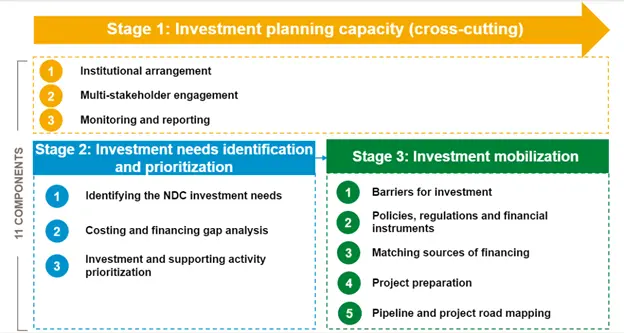Lessons from Jordan's NDC Investment Planning: Aligning Climate and Development Goals Through Prioritization Exercises
Identifying effective ways to align climate and development priorities and translate plans into specific investment opportunities to benefit different segments of society are common challenges faced by many countries. Jordan’s NDC revision and investment planning process illustrates distinctive solutions to address these challenges by incorporating a set of criteria and inputs from diverse stakeholders, resulting in a pipeline of concrete project opportunities to mobilize NDC investments.
When compared against overall lessons in NDC investment planning, several best practices can be extracted from Jordan’s experience.

Investment Planning Capacity
Jordan’s NDC revision and investment planning processes were led by the Ministry of Environment (MoE) as the chair of the National Climate Change Committee (NCCC). The committee is responsible for strategic oversight of climate action in the country, serving as the focal point for the UNFCCC. This represents effective practice as it provides a clear institutional arrangement for (1) coordinated action at the national level, (2) streamlined management of the Measurement, Reporting and Verification System, as well as (3) inclusive stakeholder engagement.
To engage subnational actors, for instance, the government also ran two pilot programs to empower local authorities in NDC investment planning. Through this work, subnational stakeholders and municipalities received technical assistance to develop local Sustainable Energy and Climate Action Plans, specifically for Greater Irbid, Karak, Aqaba Special Economic Zone, among others. These build local capacity and support sub-national arrangements to deliver climate action, providing unique input to ongoing coordination with sector working groups engaged in the process of identifying investment needs.
In addition, the Ministry of Finance is working to introduce a climate finance tracker, which will facilitate tracking NDC expenditures and updating the NDC action plan with current and planned activities. The climate finance tracker will ensure closer alignment between sectors and the NDC target, helping to coordinate actions to raise NDC investment. In addition, here are actions undertaken by the Government that contribute to the NDC but are not summarized in the NDC action plan. This means that while NDC investment planning is not yet fully aligned with ongoing government expenditure and investment, the tool would enable a centralization of current and planned activities.
Investment Need Identification and Prioritization
Investment needs were identified through a consultative process. The process was led by sectors and coordinated by the NCCC. Stakeholders identified the actions and investments from national strategies which contributed to NDC goals. To this end, Jordan developed the NDC Action Plan outlining investment needs, summarized as actions, to achieve NDC targets in prioritized sectors (energy, water, health, agriculture, and transport). Sector working groups identified each sector’s pipeline of programs and projects based on emission reduction potential, sustainable development benefits, implementation readiness, and degree of alignment with national development priorities.
Building on this work, the country conducted a cost benefit analysis of the 35 priority actions identified through the prioritization process. This included collection of sector data on each of the priority actions, its components, associated costs, and co-funding. The cost estimates were verified against the cost of similar actions and activities taken elsewhere in the region. Desk research enabled an assessment of the potential of mitigation, adaptation, and co-benefits of each action.
A series of indicators were used to identify the top priority actions in the NDC action plan. These assessed the impact potential, paradigm shift potential, sustainable development potential, gender & vulnerability issues, and readiness of each action. The sector working groups then applied the indicators to identify the final set of priority actions.
Investment Mobilization
As a next step, Jordan produced a Climate Finance Strategy, summarizing the process of mapping projects to priority activities and identifying funding sources. For each relevant sector (Water, Agriculture, Health, Transport, Energy), a long-list of international and domestic funders and development partners was identified. Through desk-based research, the assessment determined which of the funding sources may be interested in the priority actions, preparing a shortlist of 37 organizations mapped to specific actions.
Way Forward
This experience showcases how a country can use the NDC process to transform high-level goals into concrete project opportunities across several sectors. As a next step, Jordan is working with partners and national stakeholders in strengthening coordination and mobilization of resources from diverse funding agencies.
